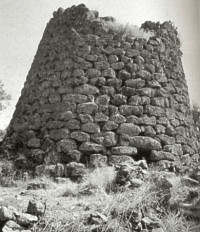
STEPHEN L. DYSON & ROBERT J. ROWLAND JR. Archaeology and history of Sardinia from the Stone Age to the Middle Ages: shepherds, sailors, & conquerors. viii+240 pages, 91 illustrations. 2008. Philadelphia (PA): University of Pennsylvania Museum of Archaeology & Anthropology; 978-1-934536-01-8 hardback $49.95.
Review by Marco Rendeli
Dipartimento di Storia, Università degli Studi di Sassari, Sardinia, Italy
(Email: rendeli@uniss.it)

This volume aims to reconstruct a historical and archaeological profile of Sardinia from the Palaeolithic to the Modern age in 220 pages rich in maps and photographs. This has been achieved: the book represents the synthesis of common research activities carried out by the two scholars, as well as the legacy of Rowland's long-term work (Rowland 2001). In the foreword, Dyson tells us that Rowland's death in 2007 meant that the volume could not undergo a final revision, an obviously vital stage for such an important book. But the many typographical errors, the confusion about some personal names and Sardinian place names are not an obstacle to comprehension.
Sardinian historical research has deeply changed in the last few years: new and fundamental contributions are modifying our understanding of the island's historical and cultural palimpsest. Sardinia has now joined the wider Mediterranean context, confronting, and engaging with, many other Mediterranean civilisations. Some omissions are present in the volume's bibliography, mostly titles published after 2000 (Giannattasio 2003; Bernardini & Zucca 2005; Mastino 2005).
The book starts with a history of Sardinian studies and portrays the attitudes of modern scholars towards the history of the island: the latter is an issue apparent in every chapter of the book, highlighting what can be termed the 'ethnic' insularity of Sardinian scholars. Research into their original roots sometimes obscures the influences from, and the relationship with, other Mediterranean cultures: it has created some 'short-circuits' in the historical interpretation of some periods.
The emergence of the Nuragic culture in the Bronze and Iron Ages has played an important role. During this period, Sardinian society and even the landscape were deeply modified: more than 8000 nuraghi were built all over Sardinia. This extraordinary proliferation implies new forms of social and political organisation: on both these topics the authors do not offer convincing solutions. There is a lack of clarity in the interpretation of the phase between the end of the Bronze Age and the beginning of the Iron Age, a period of deep and rapid transformation in Nuragic society: the emergence of an aristocracy, a different settlement organisation and the monumentalisation of federal sanctuaries are the clues to a process of change which has to be interpreted in a positive way and must be read in connexion with the cultural and material exchange with people from the East arriving in Sardinia.
I wonder if, in this phase, the concentration into larger, more receptive and better organised sites (such as Su Nuraxi at Barumini, Genna Maria at Villanovaforru, S. Imbenia and Palmavera at Alghero which in a certain sense became 'cities') can allow for the interpretation of a Sardinia comprising multiple powers engaged in reciprocal confrontations and dialogues, and with merchants from all over the Mediterranean present. In this perspective, the role of local organisation during the Phoenician phase (seventh-sixth century BC), well analysed in the volume, could have a different significance: the Sardinians could well act as strong partners in dialogue and relationships in certain areas, deeply influencing and integrating foreign patterns in other limited districts of the island.
A phase which, for many features, can be considered revolutionary begins with the middlendash;late Archaic period (mid sixth century BC onwards): the never-completed Carthaginian conquest of Sardinia and the ensuing Roman rule over the island after 238 BC need further re-thinking. The volume lacks, in my opinion, a discussion of the nature of this conquest (but see the important chapters in van Dommelen 1998): a precise will to change society, culture and patterns of organisation lies behind the conquest by Carthage. This long and difficult phase represents the 'litmus test' for the previous Sardinian organisation, eventually overtaken by the Carthaginian drive for reconstruction and reorganisation; it involves, with the birth of the relationship between cities and the countryside, not only the ancient Phoenician colonies, but also the whole of southern and central Sardinia.
The Roman conquest of Sardinia will not affect this profound reorganisation of the territory: the 'old' Punic cities will change their appearance only at the end of Roman republic, with the building in urban centres of fora, temples, thermae, theatres, amphitheatres and aqueducts. But this revolutionary transformation in the cities did not change the strong relationship the provincia Sardinia had with North Africa and which will last until the Arab conquest of Carthage.
The phase which marks the passage from late antiquity to the Middle Ages suffers from deep gaps in research. Sardinia appears to be a no-man's land, and we must ask ourselves whether our means of detection are effective enough to reconstruct a history of the Sardinian landscape from the eighth century AD onwards. It is clear that from the late tenth and eleventh centuries onwards that the history of Judicial Sardinia is defined by documentary sources more than by archaeological ones. This is an area where much work remains to be done.
In conclusion, this is a useful volume for those who want to discover the history of this beautiful Mediterranean island: Sardinia preserves a real treasure of millenary traditions and customs that are the result of a long history, during which many conquerors were fascinated by the island and became integrated as Sardinians.
